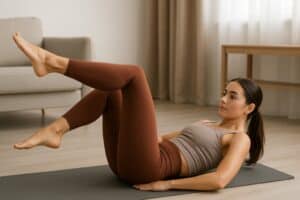
High-intensity exercises and cardio training usually attract a lot of attention, but taking it easy might prove to be much more effective. Pilates is one such activity that makes it possible to attain strength, balance, and control with minimal physical stress. This is a low-intensity exercise programme that targets those who prefer slower movements that promote effective fitness levels.
Why Slow and Steady Works
As is typical of most traditional exercise routines where one has to aim at moving the fastest and lifting the heaviest, Pilates in its form is all about movement, breathing, and form. This way, the stabilising muscles are activated, the core is engaged with every motion, and the alignment is improved—all together contributing to long-lasting strength and posture.
There are specific reasons for this phenomenon:
- More Mind-Muscle Connection: Slow movements promote the ability to concentrate on the technique.
- More Core Involvement: Whenever the movement is controlled, the abdominal muscles have to be constantly used.
- Less Chance of Injury: With impact and fast-paced movements held down, good form is used and joints are spared.
Full-Body Results Without High Impact
Some classify Pilates as a “gentle” workout; however, it is definitely capable of obtaining noteworthy achievements. Because it is low impact, it can be practiced by anyone, including those reaching for the stars in sports.
Here are some of the most notable examples:
- Flexibility: Palatable stretches throughout the workout strain the muscles and lengthen them.
- Posture: Strengthening the core supports a more upright and aligned spine.
- Movements Conducive to the Protection of Joints: The movements do not affect the hips, back, or knees.
Who Should Try Slower Training?
One of the target audiences of slower exercises such as Pilates includes individuals who:
- Have or are prone to sustaining an injury
- Want to exercise in a manner that does not impact their joints
- Prefer to sculpt rather than bulk up
- Want to enhance their core muscles as well as balance skills.
Incorporating Pilates in Everyday Life Strategically
It is not necessary to have a schedule or be a member of a studio in order to begin any form of activity. You may do so through guided routines or online classes in the comfort of your homes.
Advice that may be useful for newbies:
- Limit yourselves to two to three classes per week—brief twenty to thirty minute workouts are more than enough to achieve any increase.
- Exercise both on the mat and using equipment—mat Pilates can be matched with either a reformer or bands to manipulate part of the body.
- Stick to the schedule—if you work out regularly, you will definitely see some changes in your core strength and the way you carry yourself.
Lasting Impact Without Burnout
Being fit does not necessarily imply doing more but doing the right thing. Pilates has in several instances been seen to be more efficient than most workouts, as it involves slow and deliberate exercises. Give your body the chance to rebuild, realign, and truly strengthen. A few mindful sessions a week could be the game-changer you’ve been waiting for.
